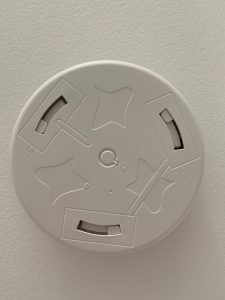FireAngel FAQ's
Read More About the Most Common Questions We Get Asked About Our Products and Fire Safety
Guidance for where to install your smoke, heat and CO alarms can be found below:

Where your alarm is installed can trigger nuisance alarms if not correctly placed, for example too close to doors or windows.

For more guidance as to where to install your smoke, heat or CO alarm please refer to your alarm’s manual or contact our friendly Customer Support team.
When fixing your alarm to the baseplate, it’s important to turn it as far as possible to ensure it is engaged and secure. If the ‘lugs’ at the rear of the alarm can be seen, then the alarm will be secure and can be installed. However, if you’re unable to turn the baseplate enough for these to be seen then we can offer an alternative baseplate.


Baseplate secure and engaged
You may find the baseplate for your alarm is a little snug, which means it will need extra force to secure when fixing to the alarm. If the ‘lugs’ at the rear of the alarm can be seen, then the alarm will be secure and can be installed. However, if you’re unable to turn the baseplate enough for these to be seen then we can offer an alternative baseplate.


Baseplate secure and engaged
You can replace your end of life device with this alarm, without requiring a new baseplate.
Looking for a FireAngel HT-630 heat alarm replacement?
Replace your end of life HT-630 alarm with a FireAngel FA6720-R Heat Alarm with 10 year sealed for life battery, to be alerted to fires without the false reactions to cooking fumes.
A quiet self-test allows you to ensure your alarm is working, without disturbing anyone else with a loud alarm.
A single press of the test button will perform a quiet self test, with the alarm volume at least 10dB below the full volume of your alarm.
A double press of the test button will perform a self test at full alarm volume (85dB@3M).
Yes – Heat Alarms won’t false alarm to dusty or humid rooms which makes them perfect for kitchens, utility rooms and garages.
Yes – heat alarms and smoke alarms detect fire in very different ways. Smoke alarms, as the name suggests, alert you to fires by detecting smoke, so if there’s a slow smouldering fire (which usually doesn’t give off a lot of heat) it could be missed for some time if a you only have a heat alarm installed. We would recommend you review the regulations specific to your area, but as a guide we recommend that homes have a smoke alarm in the hallway, landing and in the room most used in the daytime, alongside a heat alarm in the kitchen.
